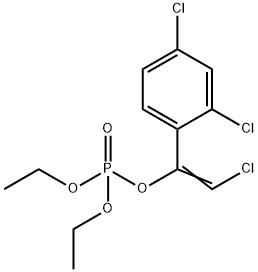클로르펜빈포스 C화학적 특성, 용도, 생산
화학적 성질
Chlorfenvinphos is a nonflammable, yellow or
amber liquid with a mild odor.
용도
Insecticide; acaricide.
제조 방법
Chlorfenvinphos is synthesized by the Perkow reaction
of triethyl phosphite with 2,4-α,α-tetrachloroacetophenone.
Technical product is an E/Z isomer mixture
with an E : Z ratio of 1 : 8–9 and an amber liquid,
bp 167–170 ?C/0.5 mm Hg, vp 1 mPa (25 ?C), sparingly
soluble in water (145 mg/L), and miscible with most
common organic solvents such as acetone and aromatic
hydrocarbons. Log Kow = 3.85. It is hydrolyzed slowly in
slightly alkaline aqueous solutions and rapidly in strongly
alkaline solutions; DT
50 values are >700 h (pH 1.1, 38 ?C),
>400 h (pH 9.1, 38 ?C), and 1.28 h (pH 13, 20 ?C).
일반 설명
Amber-colored liquid with a mild chemical odor. Used for control of ticks, flies, lice, and mites on cattle and for blowfly, lice, ked, and itchmite on sheep. Controls fleas and mites on dogs; not used on cats. Applied on organic wastes and breeding places of fly larvae. Also used as a foliage insecticide for potatoes, rice, maize, and sugar cane. Used to control soil insects.
공기와 물의 반응
Slightly soluble in water.
반응 프로필
Organophosphates, such as Chlorfenvinfos, are susceptible to formation of highly toxic and flammable phosphine gas in the presence of strong reducing agents such as hydrides. Partial oxidation by oxidizing agents may result in the release of toxic phosphorus oxides.
위험도
A cholinesterase inhibitor.
건강위험
Acute: cholinesterase inhibitor which affects central nervous system. Severe illness or death possible. Convulsions or coma and death.
화재위험
(Non-Specific -- Organophosphorus Pesticide, Liquid, n.o.s.) Chlorfenvinfos may burn but does not ignite readily. Container may explode in heat of fire. Fire and runoff from fire control water may produce irritating or poisonous gases. Avoid iron, steel, and brass. Stable when stored in glass or polyethylene lined containers. Avoid alkaline aqueous solutions.
Safety Profile
Poison by ingestion,
skin contact, intraperitoneal, subcutaneous,
and intravenous routes. Human systemic
effects by skin contact: unspecified blood
system effects. Mutation data reported. A
cholinesterase inhibitor. An insecticide. See
also PARATHION. When heated to
decomposition it emits very toxic fumes of
Cland POx.
잠재적 노출
Used as a soil insecticide for root
maggots, rootworms, and cutworms. Those engaged in the
production, formulation, and application of this insecticide.
환경귀착
The mechanism of toxicity of chlorfenvinphos is related to its
binding and inhibition of the serine hydrolase AChE. In the
nervous system, AChE hydrolyzes the neurotransmitter acetylcholine,
thereby terminating its synaptic action. AChE inhibition
increases the availability of acetylcholine at the neural
synapse, leading to cholinergic overstimulation, autonomic
and neuromuscular dysfunction, and at higher levels, resulting
in coma and death. Major metabolites of chlorfenvinphos do
not inhibit ChE. Chlorfenvinphos inhibits butyrylcholinesterase
which may function as a molecular scavenger for anti-ChE
compounds in the blood or substitute for AChE where it is low.
The stress responses to acute exposure of chlorfenvinphos
are evidenced in rats by rapidly increased plasma corticosterone
concentrations and a prolonged reduced sensitivity to psychostimulants
such as amphetamine. These effects were
attributed to the hyperactivity of the cholinergic system from
ChE inhibition, leading to persistent alterations of the brain
cholinergic–dopaminergic balance.
Other potentially more sensitive non-ChE targets that may
influence the overall toxicity of chlorfenvinphos include lipid
metabolism, oxidative stress, aromatic amino acid transferases,
and cytotoxicity. Chlorfenvinphos may act via central noradrenergic
mechanisms to induce hypotension by accelerating the
noradrenaline turnover in the brain. Chlorfenvinphos induces
hepatic CYPs.
운송 방법
UN3018 Organophosphorus pesticides, liquid,
toxic, Hazard Class: 6.1; Labels: 6.1-Poisonous materials.
비 호환성
Incompatible with oxidizers (chlorates,
nitrates, peroxides, permanganates, perchlorates, chlorine,
bromine, fluorine, etc.); contact may cause fires or
explosions. Keep away from alkaline materials, strong
bases, strong acids, oxoacids, epoxides. Strong oxidizers may
cause release of toxic phosphorus oxides. Organophosphates,
in the presence of strong reducing agents such as hydrides,
may form highly toxic and flammable phosphine gas. Keep
away from alkaline materials. May be corrosive to metals in
the presence of moisture.
폐기물 처리
Destruction by alkali hydrolysis or incineration. In accordance with 40CFR165, follow recommendations for the disposal of pesticides and
pesticide containers. Must be disposed properly by following package label directions or by contacting your local or
federal environmental control agency, or by contacting
your regional EPA office.
클로르펜빈포스 준비 용품 및 원자재
원자재
준비 용품








